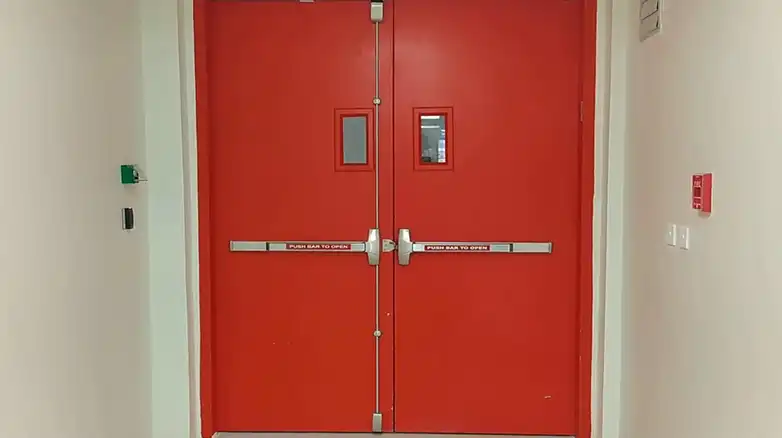What is a Class B Door? An In-Depth Exploration
Fire doors are an integral part of a building’s passive fire protection system. They act as barriers to prevent or slow the spread of fire and smoke from one area to the next. Fire doors are rated by the time they can withstand fire exposure under standard test conditions. The fire resistance rating marking on the door indicates how long it can maintain its integrity and temperature rise performance when exposed to fire. Class B doors are a specific type of fire door assembly designed and tested to meet a 1.5-hour fire rating.
Class B fire doors are extensively used as fire barriers in commercial and institutional buildings. They are installed in walls requiring a moderately high fire rating of 90 minutes. Class B doors are manufactured with fire-resistant cores, materials, and components to provide the expected fire-resistance performance. When exposed to fire, Class B doors are designed to prevent the passage of flames for 90 minutes. They also control the temperature rise on the unexposed side during a fire.
This article provides a detailed overview of Class B fire doors. It covers the key performance criteria, construction features, applications, code requirements, and benefits of using 1.5-hour Class B fire door assemblies to protect building occupants and assets in the event of a fire emergency. Read on to learn all about the critical fire protection role of Class B doors in life safety and property protection strategies.

Overview of Fire Doors and Their Ratings
Fire doors are rated by the length of time they can withstand fire and heat exposure before allowing flames or smoke to pass through. Fire door ratings, such as 20 mins, 30 mins, 45 mins, 60 mins, 90 mins, or 3 hours, indicate the duration for which the door can maintain its integrity and temperature rise performance criteria when exposed to standardized fire test conditions.
The fire-resistance rating of a door assembly indicates the duration of fire exposure it can sustain before failing. Fire doors are tested to standard test methods such as UL10B, UL10C, NFPA 252, or CAN4 S104. The ratings are not related to how long a fire door will ‘burn’ for. Rather, it specifies the door’s ability to contain fire and smoke, prevent the passage of flames, and control the temperature rise on the unexposed side of the door.
Classifications of Fire Doors
Fire doors are classified into the following categories based on their fire resistance ratings:
- Class A – 3 hours (180 minutes) fire rating
- Class B – 1.5 hours (90 minutes) fire rating
- Class C – 1 hour (60 minutes) fire rating
- Class D – 3/4 hour (45 minutes) fire rating
- Class E – 1/2 hour (30 minutes) fire rating
- Class F – 1/3 hour (20 minutes) fire rating
The class and fire rating are marked on the fire door’s label. Class B fire doors provide moderate fire resistance of 1.5 hours. This rating is suitable for many commercial, institutional, and industrial applications.
Performance Criteria for Class B Fire Doors
For a door assembly to qualify as a Class B door, it must meet certain criteria when tested to the standard fire test methods:

Fire Resistance – The door must prevent the passage of flames and hot gases for 1.5 hours when exposed to fire from the furnace side. Class B doors are expected to maintain their integrity without cracking or opening under fire exposure.
Temperature Rise – The temperature on the unexposed side of the door must not increase by more than 250°F (139°C) above ambient after 30 minutes of fire exposure. The average temperature rise should not exceed 450°F (250°C) at the 1.5-hour mark.
Hose Stream Test – After fire resistance testing, the door must withstand the impact, erosion, and cooling effects of a high-pressure hose stream without developing any openings. This test evaluates the door’s post-fire integrity.
Class B fire doors are manufactured to provide reliable fire resistance performance meeting the above criteria consistently when subjected to the standard fire endurance test.
Materials and Construction of Class B Fire Doors
Class B fire doors feature fire-resistant materials, components, and construction methods to achieve the required 1.5-hour fire rating. Common materials and design features include:
Fire-rated Core – The core material of the door must contain non-combustible ingredients like mineral wool, calcium silicate, vermiculite, or Portland cement. The core provides structural integrity.
Fire-resistant Facing – Class B doors require fire-resistant facings on both faces of the core. The facings (typically wood, steel, or composites) protect the core from fire exposure.
Laminates – Decorative and protective laminate sheets made of fire-resistant materials can be bonded to the door facings.
Intumescents – These are special heat-activated sealants that expand under fire exposure to seal gaps and prevent the passage of smoke. Intumescent strips are installed in the door edges and meeting stiles.
Hardware Protection – Internal blocks protect hardware components like locks, latches, and hinges that would otherwise create weak spots.
Self-closing Mechanism – Class B fire doors must self-close and latch when not held open by a releasing device. This prevents fire from spreading through an open door.
Labeled Glazing – Vision panels, if any, must use fire-rated glazing tested for a 1.5-hour rating. The glazing stops and frames also require fire protection.
Plugs and Sealants – Openings created for hardware preparation must be properly plugged and sealed to avoid gaps that could allow flame or smoke leakage.
Positive Pressure Testing – Completed door assemblies are tested for air leakage under pressure differentials before getting certified. Proper air sealing is checked.
Applications and Usage of Class B Fire Doors
The 1.5 hours fire rating makes Class B doors suitable for the following typical applications:
- Fire doors in interior walls of commercial and institutional buildings like offices, hospitals, schools, retail stores, etc.
- Stairwell enclosures and exit passageway doors require moderate fire resistance.
- Corridor walls and horizontal exits where 1.5-hour fire barriers are mandated by building codes.
- Doors in fire-rated partitions subdividing large commercial, industrial, or storage occupancies into fire zones.
- Smoke barriers, firewalls, and protected shafts and refuge areas with 1.5-hour fire separation requirements.
- Protection of openings in exterior walls located less than 5 feet from the property line.
Class B doors are generally not used where a high fire rating of 3 hours is required, such as for firewalls. They also cannot substitute for Class C doors where 1 hour of fire protection is needed. Specific code requirements dictate where Class B fire doors are acceptable.
Codes and Standards for Class B Doors
Installation and performance of Class B fire doors must comply with building codes and fire test standards. Some key regulations include:
IBC – International Building Code specifies required fire ratings and permitted applications for Class B doors.
NFPA 80 – Provides installation, inspection, and maintenance criteria for all fire door assemblies.
NFPA 105 – Standard for the installation of 1.5-hour Class B doors in smoke barriers.
NFPA 252 – Fire endurance test standard referenced to qualify Class B door designs.
UL 10B – Outlines procedures for fire testing of door assemblies to determine ratings.
UL 10C – Standard fire tests for positive pressure evaluation of fire door assemblies.
Class B fire doors must have legitimate certification from organizations like UL, FM Global, or WHI based on successful fire testing. The labels on the door must identify the fire rating and testing standard.
Benefits of Using Class B Fire Doors
Specifying and installing Class B fire doors provides the following benefits:
Fire Resistance – The 1.5-hour rating provides adequate protection for many areas where moderate fire resistance is sufficient.
Smoke Containment – Class B doors play a key role in compartmentation strategies for limiting smoke spread.
Passive Fire Protection – They function automatically without electrical power or human intervention.
Building Code Compliance – Class B doors meet code requirements for fire barriers in commercial occupancies.
Property Protection – They protect assets and inventory from fire damage.
Life Safety – Class B doors maintain tenable conditions along escape routes by limiting smoke infiltration.
End Note
Class B fire doors with a 1.5-hour fire resistance rating provide an important passive fire protection element in commercial, institutional, and industrial facilities. From fire-rated materials to positive pressure testing, Class B doors incorporate various design features, construction details, and performance attributes to meet the 90-minute fire endurance criteria. When specified and installed correctly, they act as barriers to contain fires and smoke within the room or area of origin. Class B doors offer vital life safety and property protection benefits by blocking fire propagation beyond the fire door opening. They are a key component of overall fire strategies as mandated by building and fire codes.
Related FAQs
What is the main purpose of a Class B fire door?
The primary purpose of a Class B fire door is to act as a barrier to prevent the passage of fire and smoke for 90 minutes when exposed to fire on one side. This delays fire spread from one fire compartment to the next.
How is the fire rating of a Class B door determined?
The 1.5-hour fire rating of a Class B door is determined by submitting a complete door assembly to a standard fire test. Ratings are based on performance to the criteria of fire resistance, temperature rise, and hose stream resistance when tested to NFPA 252, UL 10B, or similar standards.
Where are Class B fire doors required by building codes?
Class B doors are mandated wherever 1.5-hour fire-rated openings are required. This typically includes fire barriers in corridors, stairwells, horizontal exits, fire-rated partitions, smoke barriers, protected shafts, exterior walls, etc. in commercial and institutional occupancies.


![[Explained] What Size Is a 3068 Door?](https://doorsuggest.com/wp-content/uploads/2023/10/What-Size-Is-a-3068-Door-768x431.webp)
![[ANSWERED] What Does a Purple Door Mean?](https://doorsuggest.com/wp-content/uploads/2023/08/What-Does-a-Purple-Door-Mean-768x431.webp)
![[Explained] Do Door Knobs Come with Strike Plates?](https://doorsuggest.com/wp-content/uploads/2023/10/Do-Door-Knobs-Come-with-Strike-Plates-768x431.webp)
![[ANSWERED] Are Mobile Home Door Knobs Different?](https://doorsuggest.com/wp-content/uploads/2023/08/Are-Mobile-Home-Door-Knobs-Different-768x431.webp)